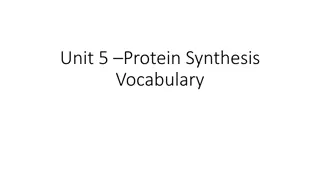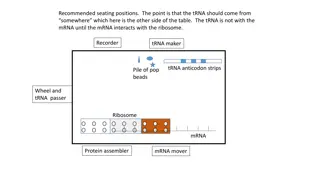Understanding Gene Translation: From RNA to Protein
Gene translation from RNA to protein involves the specific binding of transfer RNA molecules to messenger RNA codons, enabling the translation of nucleotide sequences into amino acids. Each amino acid is attached to a specific tRNA through activating enzymes, and the anticodon on tRNA pairs with the
0 views • 4 slides
Understanding Protein Synthesis Process
Explore the essential vocabulary related to protein synthesis, including RNA types like mRNA, rRNA, tRNA, amino acids, codons, and anticodons. Learn about the two key steps in protein synthesis - transcription and translation - and how they work together to create proteins in living cells.
0 views • 11 slides
Understanding Protein Synthesis Process in Cells
Explore the key terms related to protein synthesis: RNA, mRNA, rRNA, tRNA, protein synthesis, transcription, translation, amino acid, codon, and anticodon. Understand the intricate process of protein formation through transcription and translation steps.
0 views • 11 slides
Understanding Protein Synthesis and Translation Process
Proteins play a crucial role in various body structures and functions. The process of translation, as per the central dogma, involves converting genetic information from DNA to functional proteins through transcription and translation. This process includes initiation, elongation, and termination st
1 views • 25 slides
Understanding RNA and Protein Synthesis Processes
RNA plays a crucial role in protein synthesis as it carries coded instructions from DNA. There are three types of RNA - mRNA, rRNA, and tRNA, each serving specific functions in the process. The steps of protein synthesis involve transcription, where DNA is copied into mRNA, and translation, where mR
0 views • 11 slides
Insights into RNA Secondary Structure Prediction by Kieran Andrews
Explore RNA secondary structure prediction methods and results, highlighting the role of tRNA and rRNA in cellular RNA composition. The process involves cycling through sequence folds, scoring based on base alignments, and identifying cis-regulatory elements. Results showcase paired bases in tRNA an
0 views • 7 slides
Exploring RNA Secondary Structure Prediction in Bioinformatics
RNA secondary structure prediction is a key concept in bioinformatics, encompassing features like stems, loops, and bulges. This presentation delves into the importance of RNA beyond mRNA, highlighting rRNA, tRNA, and regulatory RNA roles. The canonical base pairs A-U and C-G shape the single-strand
0 views • 20 slides
Understanding Nucleic Acids and RNA Molecules
Nucleic acids are linear polymers composed of nucleotides, with DNA and RNA being the main types. RNA consists of messenger RNA (mRNA), transfer RNA (tRNA), and ribosomal RNA (rRNA), each playing a crucial role in protein synthesis. mRNA carries genetic information from DNA to ribosomes, tRNA transf
0 views • 8 slides
Role of RNA in Biological Processes and Protein Synthesis
Ribonucleic acid (RNA) is a crucial polymeric molecule in various biological functions including coding, decoding, gene regulation, and expression. It works alongside DNA and plays a key role in protein synthesis. There are three major types of RNA - rRNA, tRNA, and mRNA, each with specific function
0 views • 5 slides
Understanding Translation in Genetic Processes
Translation is the process of converting RNA messages into amino acids in cells. This key step in gene expression involves decoding codons, utilizing tRNA as adaptors, and following the genetic code to produce proteins. The shared genetic code, the role of tRNA in carrying amino acids, and the conti
0 views • 10 slides
Recommended Seating Positions for Molecular Biology Class
Explore the recommended seating positions for a molecular biology class, ensuring the tRNA flows smoothly across the table to interact with the mRNA and ribosome. Discover the model of the ribosome and essential details for creating an engaging learning environment for students. Begin the translatio
0 views • 8 slides
Understanding Protein Synthesis: The Molecular Machinery Behind Protein Production
Delve deep into the intricate process of protein synthesis, from transcription to translation, exploring the roles of DNA, mRNA, ribosomes, tRNA, and amino acids. Uncover the fascinating mechanisms that culminate in the creation of functional proteins, likened to baking a complex recipe. Discover th
0 views • 12 slides
Understanding Kinetic Proofreading in Biological Systems
Kinetic proofreading is a crucial mechanism by which the body accurately discriminates between closely-related molecules, such as mRNA codons and tRNA molecules in the process of protein synthesis. This process ensures that the correct molecules bind together, preventing errors that could have sever
0 views • 55 slides
Understanding Cells: From Genes to Proteins Post-Test
Explore key concepts in cell biology through a post-test that covers information on genetic inheritance, universal compounds in living organisms, transcription processes, genomic similarities, and nucleic acid functions. Test your knowledge on where genetic information resides in cells, the differen
0 views • 6 slides
Protein Synthesis Process Explained with Mrs. Griffiths
The protein synthesis process involves transcription where mRNA is made from DNA, followed by translation where tRNA molecules bring amino acids to assemble a polypeptide chain. This detailed explanation by Mrs. Griffiths covers the steps of DNA unwinding, mRNA formation, tRNA activation, ribosome a
0 views • 26 slides














